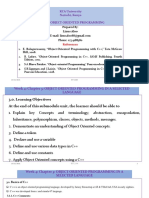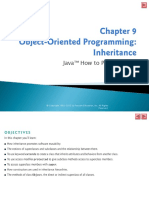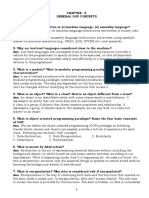Chapter 4. Class and Object
Uploaded by
minhquangelChapter 4. Class and Object
Uploaded by
minhquangelChapter 4.
CLASS and OBJECT
Chapter 4. CLASS and OBJECT
Minh Quang Nguyen
Hanoi National University of Education
September 2015
Chapter 4. CLASS and OBJECT
Class and Class members
Encapsulating class components
Implementing functions in class
Static class members
this Pointer
Constructor
Q&A
Chapter 4. CLASS and OBJECT
Class and Class members
Introduction
Classes are the central feature of C++ that supports
object-oriented programming and are often called user-defined
types
I
A class is a category of objects; it is a new data type you
create that is more complex than the basic data types
A class is used to specify the form of an object and it
combines data representation and methods for manipulating
that data into one neat package.
The data and functions within a class are called members of
the class.
Chapter 4. CLASS and OBJECT
Class and Class members
Introduction
Classes are the central feature of C++ that supports
object-oriented programming and are often called user-defined
types
I
A class is a category of objects; it is a new data type you
create that is more complex than the basic data types
A class is used to specify the form of an object and it
combines data representation and methods for manipulating
that data into one neat package.
The data and functions within a class are called members of
the class.
Chapter 4. CLASS and OBJECT
Class and Class members
Introduction
Classes are the central feature of C++ that supports
object-oriented programming and are often called user-defined
types
I
A class is a category of objects; it is a new data type you
create that is more complex than the basic data types
A class is used to specify the form of an object and it
combines data representation and methods for manipulating
that data into one neat package.
The data and functions within a class are called members of
the class.
Chapter 4. CLASS and OBJECT
Class and Class members
Introduction
Classes are the central feature of C++ that supports
object-oriented programming and are often called user-defined
types
I
A class is a category of objects; it is a new data type you
create that is more complex than the basic data types
A class is used to specify the form of an object and it
combines data representation and methods for manipulating
that data into one neat package.
The data and functions within a class are called members of
the class.
Chapter 4. CLASS and OBJECT
Class and Class members
Structure
Example
class
{
data members
function members
};
class Student
{
int id_num;
string last_name;
double grade_point_average;
};
Chapter 4. CLASS and OBJECT
Class and Class members
Object declaration and use
To declare Student object, the Student name is used just as you
use scalar type names.
Student David;
To refer to the specific attributes of the object:
object_name.atttribute;
Example:
David.id_num = 7645;
cout << David.id_num;
Cannot access private class member declared in class Student
Chapter 4. CLASS and OBJECT
Class and Class members
Object declaration and use
To declare Student object, the Student name is used just as you
use scalar type names.
Student David;
To refer to the specific attributes of the object:
object_name.atttribute;
Example:
David.id_num = 7645;
cout << David.id_num;
Cannot access private class member declared in class Student
Chapter 4. CLASS and OBJECT
Class and Class members
Access modifier
By default, all members of a class are private, meaning they
cannot be accessed using any statements in any functions that are
not also part of the class.
Declare class data members to be public instead of private.
class Student
{
public:
int id_num;
string last_name;
double grade_point_average;
};
Using the keyword public means that the fields are now accessible
when they are used with a Student object in a main() function.
Chapter 4. CLASS and OBJECT
Encapsulating class components
What is encapsulating
When you create a class name for a group of associated variables,
you contain, or encapsulate, the individual components.
Programmers sometimes refer to encapsulation as an example of
using a black box.
A black box is a device that you can use, but cannot look inside to
see how it works.
In contrast, the interface intercedes between you and the more
complicated inner workings of the radio
Chapter 4. CLASS and OBJECT
Encapsulating class components
What is encapsulating
When you create a class name for a group of associated variables,
you contain, or encapsulate, the individual components.
Programmers sometimes refer to encapsulation as an example of
using a black box.
A black box is a device that you can use, but cannot look inside to
see how it works.
In contrast, the interface intercedes between you and the more
complicated inner workings of the radio
Chapter 4. CLASS and OBJECT
Encapsulating class components
What is encapsulating
When you create a class name for a group of associated variables,
you contain, or encapsulate, the individual components.
Programmers sometimes refer to encapsulation as an example of
using a black box.
A black box is a device that you can use, but cannot look inside to
see how it works.
In contrast, the interface intercedes between you and the more
complicated inner workings of the radio
Chapter 4. CLASS and OBJECT
Encapsulating class components
Designing a class: A&Q
Before designing a new class, some questions and its answers must
be stated. For example, when designing class Student
I Q: What shall we call it?
I A: Student.
I Q: What are its attributes?
I A: It has an integer ID number, a string last name, and a
double grade point average.
I Q: What methods are needed by Student?
I A: A method to assign values to a member of this class (for
example, one Students ID number is 3232, her last name is
Walters, and her grade point average is 3.45).
I Q: Any other methods?
I A: A method to display data in a member of this class (for
example, display one Students data).
Chapter 4. CLASS and OBJECT
Encapsulating class components
Designing a class: an Example
For most object-oriented classes, then, you declare both fields and
functions
I
You declare a field using a data type and an identifier.
You declare a function by writing its prototype, which serves
as the interface to the function
class Student
{
private:
int id_num;
string last_name;
double grade_point_average;
public:
void display_student_data();
};
Chapter 4. CLASS and OBJECT
Implementing functions in class
Implementation section: what is it?
The first part is a declaration section, which contains the class
name, variables (attributes), and function prototypes. The second
part created is an implementation section, which contains the
functions themselves.
I Implementation is in class interface
I Implementation is outside class interface
class Student
{
private:
int id_num;
public:
int get_id_num()
{
return id_num;
}
};
Chapter 4. CLASS and OBJECT
Implementing functions in class
Implementation section: example
Example
// implementation section:
void Student::displayStudentData()
{
cout << "Student #" << idNum << "s last name is " <<
lastName << endl;
cout << "The grade point average for this student is " <<
gradePointAverage << endl;
}
Chapter 4. CLASS and OBJECT
Static class members
Why is static?
When objects are instantiated, each one gets its own block of
memory for its data members. For example, if you create an array
of 100 objects, 100 blocks of memory are set aside
Sometimes every instantiation of a class requires the same value.
For example
100 Student objects, all Students need their own ID and
grade point average, but not all Students need their own
copy of the athletic fee figure. If each Student object
contains a copy of the athletic fee, you repeat the same
information 100 times, wasting memory.
To avoid this, you can declare the athletic fee variable as static,
meaning that only one memory location is allocated, no matter
how many objects of the class you instantiate.
Chapter 4. CLASS and OBJECT
Static class members
Why is static?
When objects are instantiated, each one gets its own block of
memory for its data members. For example, if you create an array
of 100 objects, 100 blocks of memory are set aside
Sometimes every instantiation of a class requires the same value.
For example
100 Student objects, all Students need their own ID and
grade point average, but not all Students need their own
copy of the athletic fee figure. If each Student object
contains a copy of the athletic fee, you repeat the same
information 100 times, wasting memory.
To avoid this, you can declare the athletic fee variable as static,
meaning that only one memory location is allocated, no matter
how many objects of the class you instantiate.
Chapter 4. CLASS and OBJECT
Static class members
Why is static?
When objects are instantiated, each one gets its own block of
memory for its data members. For example, if you create an array
of 100 objects, 100 blocks of memory are set aside
Sometimes every instantiation of a class requires the same value.
For example
100 Student objects, all Students need their own ID and
grade point average, but not all Students need their own
copy of the athletic fee figure. If each Student object
contains a copy of the athletic fee, you repeat the same
information 100 times, wasting memory.
To avoid this, you can declare the athletic fee variable as static,
meaning that only one memory location is allocated, no matter
how many objects of the class you instantiate.
Chapter 4. CLASS and OBJECT
Static class members
Why is static?
When objects are instantiated, each one gets its own block of
memory for its data members. For example, if you create an array
of 100 objects, 100 blocks of memory are set aside
Sometimes every instantiation of a class requires the same value.
For example
100 Student objects, all Students need their own ID and
grade point average, but not all Students need their own
copy of the athletic fee figure. If each Student object
contains a copy of the athletic fee, you repeat the same
information 100 times, wasting memory.
To avoid this, you can declare the athletic fee variable as static,
meaning that only one memory location is allocated, no matter
how many objects of the class you instantiate.
Chapter 4. CLASS and OBJECT
Static class members
Why is static?
When objects are instantiated, each one gets its own block of
memory for its data members. For example, if you create an array
of 100 objects, 100 blocks of memory are set aside
Sometimes every instantiation of a class requires the same value.
For example
100 Student objects, all Students need their own ID and
grade point average, but not all Students need their own
copy of the athletic fee figure. If each Student object
contains a copy of the athletic fee, you repeat the same
information 100 times, wasting memory.
To avoid this, you can declare the athletic fee variable as static,
meaning that only one memory location is allocated, no matter
how many objects of the class you instantiate.
Chapter 4. CLASS and OBJECT
Static class members
Defining
Structure
static data_type variable_name;
A static data member is defined (given a value) in a single
statement outside the class definition.
class Student
{
private:
int idNum;
static double athleticFee;
public:
void setIdNum(int);
int getIdNum();
double getAthleticFee();
};
Chapter 4. CLASS and OBJECT
Static class members
Some features of static data member
A static class member exists, even when you have not
instantiated any objects of the class.
They belong to the class, and you can use them even if you
never instantiate an object.
For a non-class member function (such as main()) to use the
static field directly, it cannot be private.
Chapter 4. CLASS and OBJECT
Static class members
Some features of static data member
A static class member exists, even when you have not
instantiated any objects of the class.
They belong to the class, and you can use them even if you
never instantiate an object.
For a non-class member function (such as main()) to use the
static field directly, it cannot be private.
Chapter 4. CLASS and OBJECT
Static class members
Some features of static data member
A static class member exists, even when you have not
instantiated any objects of the class.
They belong to the class, and you can use them even if you
never instantiate an object.
For a non-class member function (such as main()) to use the
static field directly, it cannot be private.
Chapter 4. CLASS and OBJECT
Static class members
Some features of static data member
A static class member exists, even when you have not
instantiated any objects of the class.
They belong to the class, and you can use them even if you
never instantiate an object.
For a non-class member function (such as main()) to use the
static field directly, it cannot be private.
Chapter 4. CLASS and OBJECT
Static class members
static function member
If static data member were private, and you wanted to access
it without using an object, you would have to use a public
function to access the value.
Additionally, the function would have to be a static function.
A static function is one you can use with or without a declared
object
Chapter 4. CLASS and OBJECT
Static class members
static function member
If static data member were private, and you wanted to access
it without using an object, you would have to use a public
function to access the value.
Additionally, the function would have to be a static function.
A static function is one you can use with or without a declared
object
Chapter 4. CLASS and OBJECT
Static class members
static function member
If static data member were private, and you wanted to access
it without using an object, you would have to use a public
function to access the value.
Additionally, the function would have to be a static function.
A static function is one you can use with or without a declared
object
Chapter 4. CLASS and OBJECT
this Pointer
It would waste space if you stored the code for the member
functions separately for each object.
C++ does not store member functions separately for each
instance of a class. Instead, one copy of each member
function is stored, and each instance of a class uses the same
function code
When calling a non-static member function, it needs to know
which object to use.
Within a member function, the address of the calling object is
stored in a special pointer called the this pointer. The this
pointer holds the memory address of the current object that is
using the function;
Example
Chapter 4. CLASS and OBJECT
this Pointer
It would waste space if you stored the code for the member
functions separately for each object.
C++ does not store member functions separately for each
instance of a class. Instead, one copy of each member
function is stored, and each instance of a class uses the same
function code
When calling a non-static member function, it needs to know
which object to use.
Within a member function, the address of the calling object is
stored in a special pointer called the this pointer. The this
pointer holds the memory address of the current object that is
using the function;
Example
Chapter 4. CLASS and OBJECT
this Pointer
It would waste space if you stored the code for the member
functions separately for each object.
C++ does not store member functions separately for each
instance of a class. Instead, one copy of each member
function is stored, and each instance of a class uses the same
function code
When calling a non-static member function, it needs to know
which object to use.
Within a member function, the address of the calling object is
stored in a special pointer called the this pointer. The this
pointer holds the memory address of the current object that is
using the function;
Example
Chapter 4. CLASS and OBJECT
this Pointer
It would waste space if you stored the code for the member
functions separately for each object.
C++ does not store member functions separately for each
instance of a class. Instead, one copy of each member
function is stored, and each instance of a class uses the same
function code
When calling a non-static member function, it needs to know
which object to use.
Within a member function, the address of the calling object is
stored in a special pointer called the this pointer. The this
pointer holds the memory address of the current object that is
using the function;
Example
Chapter 4. CLASS and OBJECT
this Pointer
It would waste space if you stored the code for the member
functions separately for each object.
C++ does not store member functions separately for each
instance of a class. Instead, one copy of each member
function is stored, and each instance of a class uses the same
function code
When calling a non-static member function, it needs to know
which object to use.
Within a member function, the address of the calling object is
stored in a special pointer called the this pointer. The this
pointer holds the memory address of the current object that is
using the function;
Example
Chapter 4. CLASS and OBJECT
this Pointer
It would waste space if you stored the code for the member
functions separately for each object.
C++ does not store member functions separately for each
instance of a class. Instead, one copy of each member
function is stored, and each instance of a class uses the same
function code
When calling a non-static member function, it needs to know
which object to use.
Within a member function, the address of the calling object is
stored in a special pointer called the this pointer. The this
pointer holds the memory address of the current object that is
using the function;
Example
Chapter 4. CLASS and OBJECT
Constructor
Constructor function is a function which is automatically
called when you create a new object.
important Constructor name is identical to class name.
Constructor(s) do not return values.
If not declaration for constructor, a default constructor is
create.
If there is a declaration of a constructor, there would be no
default constructor.
Chapter 4. CLASS and OBJECT
Constructor
Constructor: Example
Example
using namespace std;
class Employee
{
private:
int idNum;
double hourlyRate;
public:
Employee();
void setIdNum(const int);
void setHourlyRate(const double);
int getIdNum();
double getHourlyRate();
};
Employee::Employee()
{
idNum = 9999;
Chapter 4. CLASS and OBJECT
Constructor
Constructor: overloading
Example
A class can have multiple
constructors, with different
parameters.
This technique is called
overloading the constructor.
class Writer
{
private:
string firstName;
string middleName;
string lastName;
// other data members can go her
public:
Writer(string, string, string)
Writer(string, string);
string toString();
// other functions can go here
};
Chapter 4. CLASS and OBJECT
Constructor
Destructor
Example
I
Only use when heap
memory is allocated for
objects. (what is heap
memory?)
Usually use for free the
memory location allocated.
class array
{
private:
char* c;
public:
array()
{
c = new char[100];
}
~array()
{
delete c;
}
Chapter 4. CLASS and OBJECT
Q&A
QUESTION and ANSWER
You might also like
- Guide To Clear Java Developer InterviewNo ratings yetGuide To Clear Java Developer Interview42 pages
- KCA University Nairobi, Kenya Bit 2108: Object Oriented ProgrammingNo ratings yetKCA University Nairobi, Kenya Bit 2108: Object Oriented Programming28 pages
- Unit - Ii: Class and Object Encapsulation and Data AbstractionNo ratings yetUnit - Ii: Class and Object Encapsulation and Data Abstraction37 pages
- Understanding The Basics:Object Oriented ConceptsNo ratings yetUnderstanding The Basics:Object Oriented Concepts47 pages
- Kabarak University Department of Computer Science.: Inte 313 Object-Oriented Analysis and DesignNo ratings yetKabarak University Department of Computer Science.: Inte 313 Object-Oriented Analysis and Design57 pages
- Object Oriented Programming Lab-03 (GetterSetter, Constructors, MemberFunctions)No ratings yetObject Oriented Programming Lab-03 (GetterSetter, Constructors, MemberFunctions)4 pages
- Object Oriented Programming: Introduction To100% (1)Object Oriented Programming: Introduction To40 pages
- Java™ How To Program, 10/e Late Objects Version: Reserved100% (1)Java™ How To Program, 10/e Late Objects Version: Reserved98 pages
- 10.object Oriented Design and UML DiagramsNo ratings yet10.object Oriented Design and UML Diagrams89 pages
- Java™ How To Program, 10/e Late Objects Version: ReservedNo ratings yetJava™ How To Program, 10/e Late Objects Version: Reserved91 pages
- Mid-Term Wakandadb: Information System ThematicNo ratings yetMid-Term Wakandadb: Information System Thematic16 pages
- Presentation Week 15 IntProg Class Pachshenko G.N.No ratings yetPresentation Week 15 IntProg Class Pachshenko G.N.36 pages
- Inheritance and Polymorphism: Object Oriented ProgrammingNo ratings yetInheritance and Polymorphism: Object Oriented Programming80 pages
- Unit - 4 Classes and Object-Oriented ProgrammingNo ratings yetUnit - 4 Classes and Object-Oriented Programming88 pages
- A405702472 - 25107 - 23 - 2020 - Lecture 17-Friend FunctionNo ratings yetA405702472 - 25107 - 23 - 2020 - Lecture 17-Friend Function16 pages
- Object Oriented Programming Interview Questions by Ammar HaiderNo ratings yetObject Oriented Programming Interview Questions by Ammar Haider12 pages
- Object Oriented Programming (OOP) - CS304 Power Point Slides Lecture 22No ratings yetObject Oriented Programming (OOP) - CS304 Power Point Slides Lecture 2234 pages
- Object Oriented Programming (OOP) - CS304 Power Point Slides Lecture 30No ratings yetObject Oriented Programming (OOP) - CS304 Power Point Slides Lecture 3030 pages
- Unit-Iv Overview of Classes, Objects, and Instances: EncapsulationNo ratings yetUnit-Iv Overview of Classes, Objects, and Instances: Encapsulation22 pages
- C++ Programming Tutorial Part II: Object-Oriented ProgrammingNo ratings yetC++ Programming Tutorial Part II: Object-Oriented Programming215 pages
- Using Classes: Object-Oriented Programming Using C++ Second EditionNo ratings yetUsing Classes: Object-Oriented Programming Using C++ Second Edition46 pages
- Lec 02 Class, Objects and Access Specifiers (1)No ratings yetLec 02 Class, Objects and Access Specifiers (1)22 pages
- Chapter 1: INTRODUCTION To Object Oriented Programming in C++No ratings yetChapter 1: INTRODUCTION To Object Oriented Programming in C++28 pages
- ASM2 PhanLamQuocViet IT16102 ProgrammingNo ratings yetASM2 PhanLamQuocViet IT16102 Programming83 pages
- Choose The Letter That Corresponds To The Correct Answer100% (4)Choose The Letter That Corresponds To The Correct Answer4 pages
- Chapter 4 Basics of Object-Oriented ConceptsNo ratings yetChapter 4 Basics of Object-Oriented Concepts35 pages
- 3. Object Oriented Programming MODIFIED bongaNo ratings yet3. Object Oriented Programming MODIFIED bonga121 pages
- Advance Object Oriented Programming (Lecture 1) : Ms. Sehresh Khan Lecturer Numl-RwpNo ratings yetAdvance Object Oriented Programming (Lecture 1) : Ms. Sehresh Khan Lecturer Numl-Rwp13 pages
- Optimization Problems Minimum Spanning Tree Behavioral AbstractionNo ratings yetOptimization Problems Minimum Spanning Tree Behavioral Abstraction114 pages
- Answer---Object Oriented Programming-2022No ratings yetAnswer---Object Oriented Programming-202210 pages
- KCA University Nairobi, Kenya Bit 2108: Object Oriented ProgrammingKCA University Nairobi, Kenya Bit 2108: Object Oriented Programming
- Unit - Ii: Class and Object Encapsulation and Data AbstractionUnit - Ii: Class and Object Encapsulation and Data Abstraction
- Kabarak University Department of Computer Science.: Inte 313 Object-Oriented Analysis and DesignKabarak University Department of Computer Science.: Inte 313 Object-Oriented Analysis and Design
- Object Oriented Programming Lab-03 (GetterSetter, Constructors, MemberFunctions)Object Oriented Programming Lab-03 (GetterSetter, Constructors, MemberFunctions)
- Java™ How To Program, 10/e Late Objects Version: ReservedJava™ How To Program, 10/e Late Objects Version: Reserved
- Java™ How To Program, 10/e Late Objects Version: ReservedJava™ How To Program, 10/e Late Objects Version: Reserved
- Presentation Week 15 IntProg Class Pachshenko G.N.Presentation Week 15 IntProg Class Pachshenko G.N.
- Inheritance and Polymorphism: Object Oriented ProgrammingInheritance and Polymorphism: Object Oriented Programming
- A405702472 - 25107 - 23 - 2020 - Lecture 17-Friend FunctionA405702472 - 25107 - 23 - 2020 - Lecture 17-Friend Function
- Object Oriented Programming Interview Questions by Ammar HaiderObject Oriented Programming Interview Questions by Ammar Haider
- Object Oriented Programming (OOP) - CS304 Power Point Slides Lecture 22Object Oriented Programming (OOP) - CS304 Power Point Slides Lecture 22
- Object Oriented Programming (OOP) - CS304 Power Point Slides Lecture 30Object Oriented Programming (OOP) - CS304 Power Point Slides Lecture 30
- Unit-Iv Overview of Classes, Objects, and Instances: EncapsulationUnit-Iv Overview of Classes, Objects, and Instances: Encapsulation
- C++ Programming Tutorial Part II: Object-Oriented ProgrammingC++ Programming Tutorial Part II: Object-Oriented Programming
- Using Classes: Object-Oriented Programming Using C++ Second EditionUsing Classes: Object-Oriented Programming Using C++ Second Edition
- Chapter 1: INTRODUCTION To Object Oriented Programming in C++Chapter 1: INTRODUCTION To Object Oriented Programming in C++
- Choose The Letter That Corresponds To The Correct AnswerChoose The Letter That Corresponds To The Correct Answer
- Advance Object Oriented Programming (Lecture 1) : Ms. Sehresh Khan Lecturer Numl-RwpAdvance Object Oriented Programming (Lecture 1) : Ms. Sehresh Khan Lecturer Numl-Rwp
- Optimization Problems Minimum Spanning Tree Behavioral AbstractionOptimization Problems Minimum Spanning Tree Behavioral Abstraction






























































































